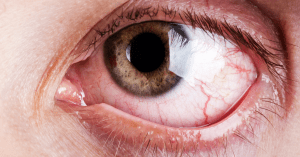Common Eye Conditions Explained
Two keys to maintaining overall eye health is understanding eye conditions and knowing when to seek treatment. Though you may be familiar with issues like dry eye and conjunctivitis, others like color blindness and amblyopia could remain a mystery.
So that you are aware of some of the more common conditions, their symptoms, and treatment options, we’ll explain a few of them below.
Common Eye Conditions Explained

Dry Eye
Dry Eye is caused when your eyes can’t lubricate themselves with tears. The eyes become inflamed, red, and sensitive to light. Eye drops are a common solution to this problem. For severe dry eyes, surgery and glasses might be treatment options.
Conjunctivitis
Conjunctivitis, also known as pink eye, occurs when the white portion of your eyeball becomes inflamed due to allergies and/or bacterial or viral infection. It is highly contagious and spread by contact with discharge from the eye of someone infected. It can be treated with eye drops, cold compresses, and antibiotic eye drops.
Color Blindness
Color Blindness, which is the inability to distinguish between certain colors, generally affects more men than women. It is most common with shades of red and green but can also include total color blindness. It is important to get all-encompassing eye exams to ensure an underlying illness isn’t the cause.
Amblyopia
Amblyopia, commonly known as lazy eye, is reduced vision in one eye. The affected eye usually wanders inward or outward and does not appear to work in tandem with the opposing eye. Poor depth perception and squinting are also byproducts of amblyopia. It can be treated with corrective devices and surgery.
Macular Degeneration
Macular Degeneration causes vision loss in the center of your field of vision. Two types of macular degeneration are “dry” and “wet”. Dry macular degeneration occurs due to thinning of the macula, the small portion of your retina responsible for sensing light. Wet occurs due to blood vessels leaking blood into the retina. Surgery, corrective lenses, and even a healthy diet and exercise can help slow the progression.
Retinal Detachment/Tear
Retinal Detachment/Tear occurs when the retina, a layer of tissue at the back of your eye that processes light, is detached or pulled from its normal position. When that happens, the retina can’t receive oxygen and vital nourishment. If left untreated it can cause permanent vision loss. Immediate medical treatment can save vision in the affected eye.
Though we’ve outline conditions and treatment, this information does not replace the need for proper diagnosis and treatment by a doctor.
If you think you may have any of the above-listed conditions or would like to schedule a routine eye exam, we can help. Please call The Eye Center, with locations in Huntsville and Madison, at 256-705-3937.
